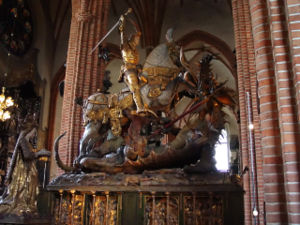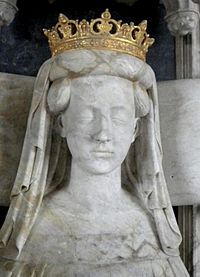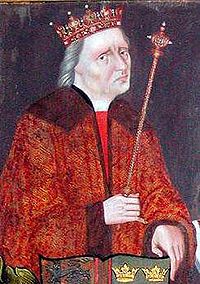- Dano-Swedish War (1470–1471)
-
Dano-Swedish War 
"St. George and the Dragon" by Bernt Notke, in Stockholm's Storkyrkan, commemorating Sture's victory at the Battle of Brunkeberg.Date 1470–71 Location Baltic Sea and Sweden Result Swedish victory Belligerents  Sweden
Sweden Denmark
Denmark
 German Knights
German KnightsCommanders and leaders Sten Sture
Nils Sture
Knut Posse † Christian I of Denmark
Christian I of Denmark
 Margaret of Denmark, Queen of Scotland
Margaret of Denmark, Queen of ScotlandStrength 10 000 Peasant Levies 3 000 Danish Troops
2 000 German KnightsCasualties and losses unknown, but less than the Danish 4 200 killed, 900 drowned, 900 captured The Dano-Swedish War was the first war between Denmark and Sweden. The Danes invaded Sweden by sea, but were defeated early at the Battle of Brunkeberg, in which King Christian I of Denmark was wounded by a cannon ball. The Danish invasion was repelled, and the Swedes were independent from the Kalmar Union.
Contents
Background
Queen Margaret I of Denmark created the Kalmar Union (Finland, Denmark, Norway, and Sweden) under her rule. Sweden soon wanted out. Sten Sture proposed the Swedish Empire, which included Sweden and Finland, and himself as the ruler. Christian I of Denmark saw the formation of Sweden a threat to his legitimate rulership of Sweden, and decided to use the formation of Sweden as an excuse to wrest it back.
The Campaign
King Christian I had 3 000 Danish troops and 2,000 allied Germans. Sture had only about 400 troops in his army, and the Danish could easily pick a fight. In late July 1471, the fleet of 76 Danish Ships with the 5,000 troops set out from Copenhagen harbor to land in southern Sweden. Sture and Nils Bossom Sture went to central Sweden to gather as much men they could for the defense of Stockholm. The Danish fleet would have to face the murderous flow of the archipelago that blocked off Stockholm, but managed, possibly with the help of a hired Swedish pilot, to anchor between Käpplingeholm and Wolf's Island (Vargö) just across the water from Stockholm Castle. Christian decided that a siege would take too long, so he landed in southern Sweden instead. Sten Sture awaited the Danes, now with 10,000 levied peasants.
The Battle of Brunkeberg
Main article: Battle of Brunkeberg Sture enters Stockholm, victorious.
Sture enters Stockholm, victorious.
On Thursday, October 10, Sten Sture and Nils Bossom Sture lead their troops north to the area which is Hötorget in Stockholm today, near Brunkeberg after which the battle was named. Sten Sture's battle plan was to trap Christian's troops in a vice; Sten would attack from the west, Nils from the east, and Knut Posse would strike out from the city itself.
Nils flanked Christian's Army, and delivered a knockout blow. In Sten's sector, he kept on charging again and again, and managed to break through. In the ensuing battle, Christian was hit in the face by musket fire. Losing several teeth, he was forced to retire from battle. The decisive turn of battle in favor of Sture's side occurred when Nils' troops broke out of the forest north of the ridge, as Posse's troops attacked from the city. This cut off a contingent of Danish troops at the Klara monastery north of the town. Posse was killed when a German or Danish soldier hit his head with an axe. However, the Danish were in retreat. Christian retired with his troops towards the island of Käpplingen (today the Blasieholmen peninsula). However, Sten's troops destroyed the makeshift bridge Christian's troops had built, causing many to drown. The battle ended a victory for Sten Sture.
Sture's victory over Christian meant his power as viceroy of Sweden was secure and would remain so for the rest of his life. According to legend, Sture had prayed to Saint George before the battle. He later paid tribute to George by commissioning a statue of Saint George and the Dragon carved by the Lübeck sculptor Bernt Notke for the Storkyrkan church in Stockholm, as an obvious allegory of Sture's battle against Christian. An altar dedicated to George was also built in the church.
Aftermath
Now that Christian's invasion was beaten off, Sture had cemented Swedish freedom. He had defeated the Kalmar Union, and Sweden had become ruler of Finland and Sweden. Christian's Denmark still held Iceland, Denmark, and Norway after the war. The two nations that were formed were Sweden and Denmark–Norway. Margaret of Denmark, Queen of Scotland died in 1486, Christian in 1481, and Sture in 1503.[1]
References
- ^ Devries, Kelly:Battles of the Medieval World
Categories:- 1470 in Europe
- 1471 in Europe
- Conflicts in 1470
- Conflicts in 1471
- Wars involving Denmark
- Wars involving Sweden
Wikimedia Foundation. 2010.


